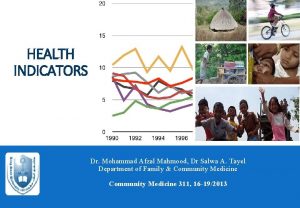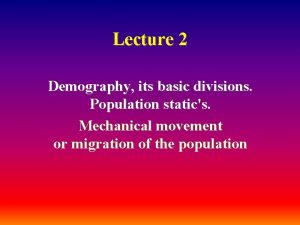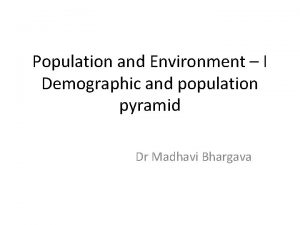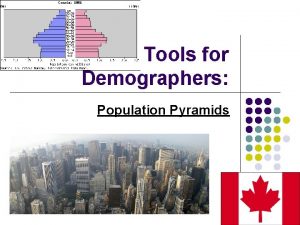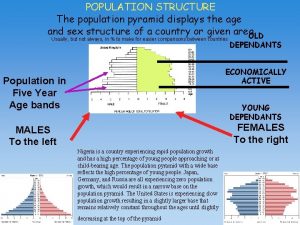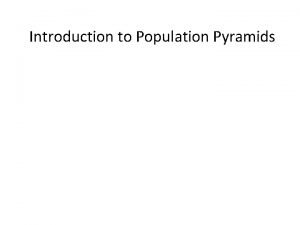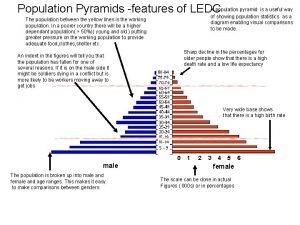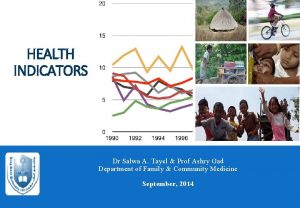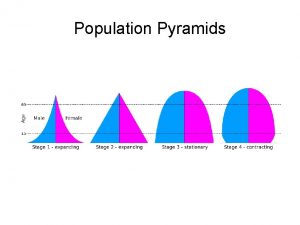DEMOGRAPHY Population Pyramids Dr Salwa Tayel Prof A




























- Slides: 28

DEMOGRAPHY: Population Pyramids Dr. Salwa Tayel & Prof. A Mandil & Prof. Ashry Gad KSU Department of Family & Community Medicine (December, 2013) 2/19/2021 1

OBJECTIVES OF THE LECTURE By the end of this lecture students will be able to: • Define demography • List elements of demography • Describe population pyramids • Compare between population pyramids of developed and developing countries. 2/19/2021 2

Definition of Demography v Demography is the science that studies human population. v Demography: The study of populations, especially with reference to size and density, fertility, mortality, growth, age distribution, migration, and vital statistics, and the interaction of all these with social and economic conditions. (Oxford Dictionary) 2/19/2021 3

Elements of Demography: Three main elements of demography: 1 - Size of population (census) 2 - Composition 3 - Distribution 2/19/2021 4

Population Census • The population size is determined by counting the inhabitants and their characteristics periodically. • Census enumeration of a population usually records identity of all persons in every place of residence, with age or birth date, sex, occupation, national origin, language, religion, marital status, income, educational level (or literacy). 2/19/2021 5

Population Census • Census data is of importance for every country for planning purposes and is usually done every 10 years. • The population size in inter-censal years (years between each census) is estimated from births, deaths and net migration. 2/19/2021 6

Types of Census: A. De Facto Enumeration: Counting all people in the locality according to their location at the time of enumeration irrespective of the person’s usual residence. De Facto census is: economic procedure and simple But, moving people can be counted twice It is adopted in the majority of countries. 2/19/2021 7

Types of Census: B. De Jure Enumeration: A de jure census assigns persons according to their usual place of residence at the time of enumeration. Expensive More difficult and takes time adopted in U. S. A. 2/19/2021 8

Last Census data of Saudi Arabia (2010/1431) Population (total) 27. 163. 977 Saudi 18. 707. 576 Males 9. 527. 173 (50. 9%) Females 9. 180. 403 (49. 1%) Non-Saudi 8. 429. 401 Males 5. 932. 974 (70. 4%) Females 2. 496. 427 (29. 6%) 2/19/2021 9

Population Pyramids 2/19/2021 10

POPULATION PYRAMIDS: THE AGE-SEX COMPOSTION OF POPULATIONS Population pyramid is the graphical presentation of the age and sex composition of a population of an area or country at a certain point in time. The shape of the pyramid reflects the major influences of births and deaths, in addition to any changes due to migration. 2/19/2021 11

Structure of Population Pyramid 2/19/2021 12

Structure of Population pyramid The right half for females 2/19/2021 13

Structure of Population pyramid Rotated Bar graph for age distribution of females 2/19/2021 14

Structure of Population pyramid Bar graph for age distribution of females 2/19/2021 15

Structure of Population pyramid Bar graph for age distribution of males 2/19/2021 16

Structure of Population pyramid Both bar graphs are rotated and put back to back 2/19/2021 17

Structure of Population pyramid • Sex – Males are shown on the left side of the pyramid – Females on the right • Age – young persons at the bottom, and – the elderly at the top. • The pyramid consists of a series of bars, each drawn proportionately to represent the percentage contribution of each age - sex group • (often in five-year groupings) to the total population • The total area of the bars represents 100 per cent of the population. 2/19/2021 18

Bases for Comparison: 1) Variation across age groups 2) Variations within each age group by sex 2/19/2021 19

The importance of the population pyramids 1. Sex ratio: Percentage of males and females. 2. Age structure: – Base denotes births (broad or narrow base) – Apex denotes elderly 3. Mortality and emigration: Shape of sides (sloping or steep). 4. Life expectancy: (Average number of years that a newborn is expected to live if current mortality rates continue to apply) Height of the pyramid and shape of the apex. 2/19/2021 20

The importance of the population pyramids 5. Median Age: (lower or higher) The point in the vertical axis of age through which passes the horizontal line that divides the surface area of the pyramid into two equal parts (50%) younger and 50% older). The position of this defined point is inversely related to the width of the base. The wider the base, (i. e. the higher the birth rate), the lower the median age and vice versa. 2/19/2021 21

The importance of the population pyramids 6. Dependency Ratio • The Dependency ratio describes the relation between the potentially self-supporting portion of the population and • the dependent portions at the extreme of age (below 15 and above 65). 2/19/2021 22

Types of Dependency Ratio • • • Young dependency: Proportion of population below 15 years of age. Old dependency: Proportion of population above 65 years of age. Total dependency: Proportion of population below 15 years of age plus the proportion of population above 65 years of age. 2/19/2021 23

Dependency Ratio 2/19/2021 24

Demographic Data of Saudi Arabia • Life expectancy at birth (2006) both sexes 70. 0 years (Female 73. 0 Male 68. 0) • Population median age (years) 24 (2006) • Population proportion over 60 (%) 4. 0 (2006) • Population proportion under 15 (%) 34. 0 (2006) 2/19/2021 25

Compare the Structure of Population pyramids Source: Joseph A. Mc. Falls, Jr. Population: A Lively Introduction. Population Bulletin 46(2); 1995: 22. 21/12/2010 26 Dr. Salwa Tayel Demography

Population Pyramid of Saudi Arabia 2009 2/19/2021 27

References • Last JM, editor. Dictionary of epidemiology. 4 th ed. New York: Oxford University Press; 2001 • World Health Statistics 2011. Indicator compendium. Indicator Code Book. World Health Statistics - World Health Statistics indicators • Core Health Indicators, Health indicators WHO. Available at: http: //apps. who. int/whosis/database/core_sel ect. cfm? str. ISO 3 2/19/2021 28
 Demographic data definition
Demographic data definition Salwa touma
Salwa touma Dr salwa ibrahim
Dr salwa ibrahim Cso business demography
Cso business demography Dr salwa malik
Dr salwa malik Static demography
Static demography Demography antonym
Demography antonym Elements of demography
Elements of demography Source of demographic data
Source of demographic data Salwa touma
Salwa touma Salmonella treatment
Salmonella treatment Rimland theroy
Rimland theroy Components of demography
Components of demography Dr salwa
Dr salwa Dubai population pyramid
Dubai population pyramid Convex population pyramid
Convex population pyramid Graph
Graph Population pyramids definition
Population pyramids definition How to read population pyramids
How to read population pyramids Idb population pyramids
Idb population pyramids Population pyramids
Population pyramids Demographic transition model population pyramids
Demographic transition model population pyramids Population pyramids
Population pyramids Beehive population pyramid
Beehive population pyramid Population pyramids
Population pyramids Why do geographers use population pyramids
Why do geographers use population pyramids Population pyramids
Population pyramids Types of population pyramids
Types of population pyramids Analyzing population pyramids
Analyzing population pyramids




